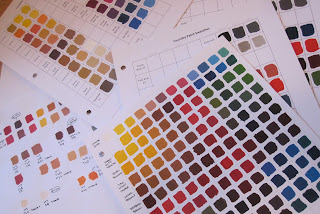La Grande Expérience - Painting Miniatures with 11 New Citadel Paints
"A real painter mixes their own colors... "
I must have a masochistic streak to have those words float across my consciousness. How does such a thought even enter one's brain? I have tons of Foundry triad paints. I also have well over 100 Vallejo colors. I never mix colors when I paint my miniatures. Ever! Why should I? I have each separate pigment of the rainbow in its separate pot already.
I have always wanted to take oil painting lessons from a quality artist and I am blessed to have an amazing studio only a block away from my house, as well as a wonderful wife who purchased lessons for me for my birthday. I was starting my oil painting lessons, and I knew from the supplies list that I would only be purchasing six colors. Six. That's it. "These colors will get you everything that you need", said my teacher when we first met as he handed me the list. I looked at his amazing art on the walls. I looked at his palette. Yep, there were six tubes of color on his palette, and a world of color on his canvas.
That cemented it. I realized that I was going to mix my own colors from here on out. But, I had to be smart about it. I wanted the least amount of drama possible, so I picked my initial colors from the new Citadel range. They had just changed over and I was reading good things about their paints. I have the excellent book Blue and Yellow Don't Make Green and I took my cue from them: I selected my colors following their instructions: two yellows (one warm/orange, one cool/green), two reds (one warm/orange, one cool/crimson), and two blues (one leaning toward green, the other toward violet). After that six, I then chose the "extras" that they recommended: some browns, a Phthalo blue and a dark green.
It was off to the local game store to try to match the paints as best as I could. Here's what I came up with: Flash Gitz Yellow, Yriel Yellow, Tau Light Ochre, Skrag Brown, Doombull Brown, Evil Sunz Scarlet, Wazdakka Red, Altdorf Guard Blue, Kantor Blue, Tecus Blue and Kabalite Green. Yes, the names of the paints are stupid.




Interesting post. As one with a pretty strong art background, I can assure you almost any color imaginable is possible with only a few basic colors. In spite of that I have managed to amass a huge collection of hobby paints most of which are seldom used. Going back to basics is sometimes the best way forward. Good luck.
ReplyDeleteRon -
ReplyDeleteThank you for your comment! I come from an art background myself, but it has been mostly pencil and some ink illustration. I haven't delved into color work too often. I know in my head that getting any color is possible from a few basic colors, but actually doing it is another thing entirely! Ha ha!
One of my challenges was not being able to get true artist's colors. I had to say to myself, "Okay, I need a Cadmium Red... what paint is that in the GW line?" I think that I did okay. Some colors are very close to each other in performance and mixing which means that I might get rid of one of them.
One thing that I am realizing is that the reds overpower other colors when mixed. I developed something called a "trace" that I am using when I am making my mixing formulas. This has allowed me to really open up and get some amazingly varied colors. For instance, adding a trace of Kabalite Green does fun things to Tau Light Ochre (a great leather base color) and Skrag Brown (I found you, khaki!).
Just to be clear, a "trace" is a tiny amount compared to the original. It is so small that you can't use the 3:1 or 6:1 ratio number successfully.
ReplyDeleteOnce I get my base color I can generally tint it up with white or yellow to find my mid-tones and highlights.
Try some artist acrylics for your color mixes. Cadmium red and yellow hues as well as cerulean and ultramarine blue are all readily available and pigment quality is much higher than most hobby paints. The natural transparency of some artist colors can be mitigated by the natural opacity of the hobby colors you mix them with. In the cases where I've used artist acrylics for miniatures, the strength and intensity of color is amazing.
ReplyDeleteRon -
ReplyDeleteI actually considered using artist's acrylics, but I heard that they were not as opaque and rugged as the hobby paints that we normally use. When I Googled it I found a few articles that went into things like adding talc to the paint to make it more opaque and having it bind better, etc. It got complicated quickly.
I had not considered combining the two together. That is an interesting idea. I'll bet that the colors are incredibly rich!
So far I have been 100% successful in mixing up the colors that I want to get, but I have not had to try for a violet or purple yet (and I may not for a little while... my SYW project doesn't have any purple in there). I'm going to try this experiment out for as long as I can with my pre-existing restrictions (Citadel paints only, etc.). We'll see how I do. I will definitely keep your excellent suggestion in mind!